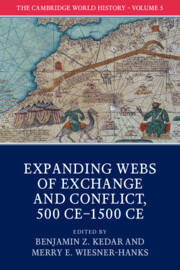Book contents
- The Cambridge World History
- The Cambridge World History
- The Cambridge World History
- Copyright page
- Dedication
- Contents
- Figures
- Maps
- Table
- Contributors
- Preface
- 1 Introduction
- Part I Global developments
- Part II Eurasian commonalities
- Part III Growing interactions
- Part IV Expanding religious systems
- Part V State formations
- Index
- References
1 - Introduction
Published online by Cambridge University Press: 05 May 2015
- The Cambridge World History
- The Cambridge World History
- The Cambridge World History
- Copyright page
- Dedication
- Contents
- Figures
- Maps
- Table
- Contributors
- Preface
- 1 Introduction
- Part I Global developments
- Part II Eurasian commonalities
- Part III Growing interactions
- Part IV Expanding religious systems
- Part V State formations
- Index
- References
Summary
- Type
- Chapter
- Information
- The Cambridge World History , pp. 1 - 40Publisher: Cambridge University PressPrint publication year: 2015

